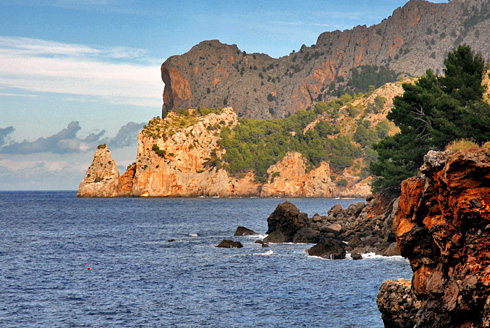Industrial Sóller electricity and a railway
Depending on how you look at it, rather than being an obstacle, difficulties can actually be an incentive for people and towns and villages to move forward. If a community has the chance to develop economically and a firm desire to do so, obstacles like the physical geography, being physically cut off or a lack of external aid can be overcome through ingenious solutions. If a group of people have it too easy, maybe they will just sit back and relax. On the other hand, impediments spur them on. One prime example of overcoming geographical difficulties is Sóller's industrial development between the 19th and 20th centuries.
Sóller underwent a boom in economic growth in about 1830, mainly thanks to its olives and oranges. Port de Sóller became one of Mallorca's leading exporters. This prosperity led to a growth in the population and many people from Sóller emigrated to America or to the South of France, helping to open up new markets and to develop an emerging textile industry. This migratory flow increased as from 1865, when a plague killed off almost all the orange trees in the valley. The new flood of emigrants, who went to live in France, Belgium and Switzerland, later returned to Sóller with their riches, facilitating a period of economic and social growth and prosperity in Sóller in the early 20th century.

Sóller is an outstanding example of the industrial development of some municipalities in the Serra de Tramuntana in the late 19th and early 20th centuries
One of the first goals was to overcome Sóller's isolated position. The Serra d'Alfàbia's magnificent mountains hindered travel between Port de Sóller and Palma or the rest of the island. Goods and passengers, carried by stagecoach, journeyed along the very steep road that crossed Coll de Sóller - the mountain pass between Sóller and Palma - with enormous difficulty. One major historical landmark was the inauguration of a railway line between Palma and Sóller in 1912 and, a year later in 1913, a tramline to the port.
In the early 20th century, given the State's reticence to invest in infrastructure, electrification and the construction of railway lines were often private initiatives. In the case of Sóller, a key role was played by Jeroni Estades i Llabrés, an M.P. and co-founder of a company called Compañía de Navegación Sollerense. He financed the construction of the railway and tramline between 1907 and 1913, using his own money and funding from local people. Estades wanted a railway line from Port de Sóller to Palma and a regular steamship line to Barcelona. He only managed to achieve the former, which still works today as a tourist attraction. To cross the Serra d'Alfàbia mountains, 13 tunnels had to be built (one of which is almost 3 km long), together with different bridges (including the famous five-bridge viaduct). The first engines on the Palma to Sóller line were steam operated, proving a great inconvenience for travellers when passing through tunnels. The line was not electrified until 1929. In contrast, the tram to the port was electrically operated right from the outset, thanks to electricity generated by an internal combustion engine at Sóller Railway Station.
The company El Gas S.A. brought gaslights to Sóller in 1893. In 1908, another company Eléctrica Sollerense, founded in 1907, built a hydroelectric power station in the municipality at Sa Costera, taking advantage of water from Font des Verger, a spring whose waters flowed toward the sea. The electricity station has been closed since the 1960s and water from Sa Costera is now piped to Sóller and Palma. One of the most spectacular hikes in the Serra de Tramuntana leads to Sa Costera.
Sa Costera power station did not produce enough electricity, and a thermal power station was also added. El Gas S.A. took over Eléctrica Sollerense's assets and ran both power stations. It is interesting to know that the voltage in Sóller was 150 volts. The transfer to 220 volts began in 1969, although last September, according to the local newspaper Veu de Sóller, 840 consumers were still waiting to be changed over from 150 volts.
Did you know that...
Jeroni Estades initially commissioned a study for a railway from Palma to Sóller that would pass through Valldemossa and Deià. He applied for the concession in 1893, but finally the project was turned down due to the high financial cost. In 1903, industrialist Joan Morell proposed the construction of a railway line straight to Palma, crossing the Serra d'Alfàbia through a tunnel just under Coll de Sóller. Initially it was also turned down, but Jeroni Estades took it up again in 1904. The final study was drawn up by engineer Pere Garau. It was made public in the same year at Sóller Town Hall, to an enthusiastic response by the people of Sóller right from the very beginning.
Bibliography
As well as the mandatory read on railways in Mallorca by Nicolau S. Canyelles i Serrano entitled El ferrocarril a Mallorca, la via del progrés (Documenta Balear, Palma, 2001), Sóller railway has inspired numerous publications. Two good examples are Ferrocarriles de Sóller y Mallorca by M. Valero and Eustaquio de la Cruz (published by Albada, Madrid, 1988) and Prodigioso tren de Sóller by Manuel Maristany and Josep Miquel (Barcelona, 1997).
GESA published a two-volume study about electricity in Mallorca entitled La electrificación de Mallorca (Gràfiques Jorvich, Palma, 1986). The first volume, which covers the period up to 1927, contains substantial information about the early days of electricity in Sóller. Mention should also be made of a book by Plàcid Pérez Pastor, entitled El gas S.A. Cent anys d'Història. 1892-1992 (Palma, 1992).




